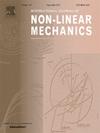基于磁流变弹性体的半主动控制准零刚度混合隔振系统
IF 2.8
3区 工程技术
Q2 MECHANICS
International Journal of Non-Linear Mechanics
Pub Date : 2025-02-25
DOI:10.1016/j.ijnonlinmec.2025.105063
引用次数: 0
摘要
准零刚度(QZS)隔振系统虽然具有优异的低频隔振性能,但存在低频与中高频隔振冲突的问题。同时,基于磁流变弹性体(MRE)的半主动控制技术可以在较宽的频率范围内取得良好的隔振效果。然而,它隔离低频振动的能力仍然有限。针对这一挑战,本文提出了一种将QZS隔振技术与基于MRE的半主动控制技术相结合的混合隔振系统。混合隔振系统由QZS隔振单元和半主动控制单元组成。倾斜弹簧提供负刚度,而MRE和线性垂直弹簧共同提供正刚度。分析了MRE试样的磁力学性能,建立了现象学本构模型。通过电磁场仿真,确定了混合系统中磁场与控制电流的关系。采用谐波法对具有非线性阻尼特性的QZS隔振器在被动模式下的隔振性能进行了评价。在半主动控制模式下,研究了混合动力系统在随机和谐波激励下的隔振性能。结果表明,该混合系统在被动模式下的隔振性能优于传统的QZS隔振器。此外,在谐波和随机激励下,该系统在半主动模式下都表现出优异的性能,具有良好的宽带低频隔振能力。本文章由计算机程序翻译,如有差异,请以英文原文为准。
A magnetorheological elastomer-based hybrid vibration isolation system with semi-active control and quasi-zero stiffness performance
The quasi-zero stiffness (QZS) vibration isolation system suffers from conflicts between low-frequency and mid-to-high-frequency isolation, despite having outstanding low-frequency vibration isolation performance. Meanwhile, the semi-active control technology based on magnetorheological elastomers (MRE) can achieve good vibration isolation effects over a wide frequency range. However, its ability to isolate low-frequency vibrations is still restricted. To address the challenge, this paper proposes a hybrid vibration isolation system that combines QZS isolation technology with semi-active control technology based on MRE. The hybrid vibration isolation system consists of the QZS vibration isolation unit and the semi-active control unit. The inclined springs provide negative stiffness, while the MRE and linear vertical spring jointly provide positive stiffness. The magneto-mechanical properties of the MRE samples are analyzed, and a phenomenological constitutive model is established. The relationship between the magnetic field and control current in the hybrid system is determined through electromagnetic field simulation. The hybrid system's vibration isolation performance in passive mode as a QZS isolator with nonlinear damping properties is assessed using the harmonic method. The hybrid system's vibration isolation performance under random and harmonic excitations is then examined in semi-active control mode. The findings demonstrate that the hybrid system outperforms traditional QZS isolators in terms of vibration isolation performance in passive mode. Furthermore, it demonstrates excellent performance in the semi-active mode under both harmonic and random excitations, with good wideband low-frequency vibration isolation capabilities.
求助全文
通过发布文献求助,成功后即可免费获取论文全文。
去求助
来源期刊
CiteScore
5.50
自引率
9.40%
发文量
192
审稿时长
67 days
期刊介绍:
The International Journal of Non-Linear Mechanics provides a specific medium for dissemination of high-quality research results in the various areas of theoretical, applied, and experimental mechanics of solids, fluids, structures, and systems where the phenomena are inherently non-linear.
The journal brings together original results in non-linear problems in elasticity, plasticity, dynamics, vibrations, wave-propagation, rheology, fluid-structure interaction systems, stability, biomechanics, micro- and nano-structures, materials, metamaterials, and in other diverse areas.
Papers may be analytical, computational or experimental in nature. Treatments of non-linear differential equations wherein solutions and properties of solutions are emphasized but physical aspects are not adequately relevant, will not be considered for possible publication. Both deterministic and stochastic approaches are fostered. Contributions pertaining to both established and emerging fields are encouraged.

 求助内容:
求助内容: 应助结果提醒方式:
应助结果提醒方式:


